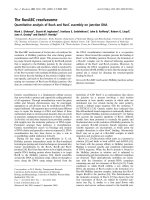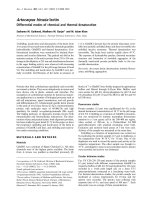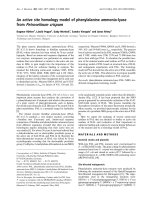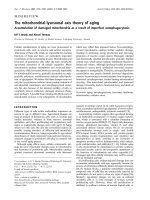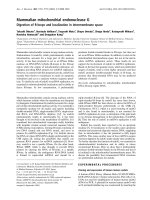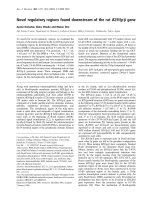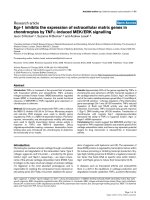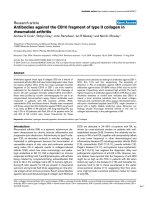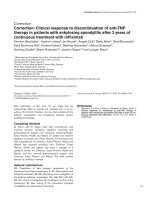Báo cáo Y học: Mammalian mitochondrial endonuclease G Digestion of R-loops and localization in intermembrane space doc
Bạn đang xem bản rút gọn của tài liệu. Xem và tải ngay bản đầy đủ của tài liệu tại đây (236.15 KB, 6 trang )
Mammalian mitochondrial endonuclease G
Digestion of R-loops and localization in intermembrane space
Takashi Ohsato
1
, Naotada Ishihara
2
, Tsuyoshi Muta
1
, Shuyo Umeda
1
, Shogo Ikeda
3
, Katsuyoshi Mihara
2
,
Naotaka Hamasaki
1
and Dongchon Kang
1
1
Department of Clinical Chemistry and Laboratory Medicine, Kyushu University Graduate School of Medical Sciences, Fukuoka,
Japan;
2
Department of Molecular Biology, Graduate School of Medical Sciences, Kyushu University, Fukuoka, Japan;
3
Department of Biochemistry, Faculty of Science, Okayama University of Science, Japan
Mammalian mitochondria contain strong nuclease activity.
Endonuclease G (endoG), which predominantly resides in
mitochondria, accounts for a large part of this nuclease
activity. It has been proposed to act as an RNase H-like
nuclease on RNAÆDNA hybrids (R-loops) in the D-loop
region where the origins of mitochondrial replication are
mapped, providing RNA primers for mtDNA replication.
However, in contrast with this proposed activity, endoG has
recently been shown to translocate to nuclei on apoptotic
stimulation and act as a nuclease without sequence specif-
icity. To clarify the role of endoG in mtDNA replication, we
examined its submitochondrial localization and its ability to
cleave R-loops. At low concentration, it preferentially
produces double-stranded breaks in R-loops, but does not
act as an RNase H-like nuclease. In addition, it exists in the
mitochondrial intermembrane space, but not in the matrix
where mtDNA replication occurs. These results do not
support the involvement of endoG in mtDNA replication.
Based on the fact that guanine tracts, which are preferential
targets of endoG, tend to form triplex structures and that
endoG produces double-stranded breaks in R-loops, we
propose that three-stranded DNA may be the preferred
substrate of endoG.
Keywords: endonuclease G; mitochondria; mitochondrial
DNA; R-loop; triplex DNA.
Mammalian mitochondria contain strong nuclease activity
which becomes evident when the membranes are disrupted
by detergents. Endonuclease G (endoG) accounts for a large
part of this mitochondrial nuclease activity. It is essentially a
nonspecific nuclease for all nucleic acid species including
double-stranded DNA, single-stranded DNA, single-stran-
ded RNA, and RNAÆDNA duplexes [1,2]. As endoG
predominantly resides in mitochondria [1], it has been
thought to be involved in the metabolism of mtDNA. It is
considered that mitochondrial transcripts stably hybridize
with template strands around conserved sequence blocks
(CSBs) during transcription, forming R-loops consisting of
two DNA strands and one RNA strand, and serve as
primers for mtDNA replication (Fig. 1A). EndoG cleaves
the RNA of a linear RNAÆDNA duplex preferentially in the
CSB region [3], raising the possibility that endoG can
generate RNA primers for mtDNA replication [3]. How-
ever, endoG is not a specific RNase. On the other hand,
RNase MRP
1
, which is also thought to provide RNA
primers by cleaving the RNA of R-loops, is a specific
RNase. In addition, the endogenous RNAÆDNA hybrid
is formed in supercoiled mtDNA and should be a
triple-stranded R-loop [4]. The cleavage of the RNA of
triple-stranded R-loops by endoG has never been shown,
while RNase MRP has been shown to cleave the RNA of
triple-stranded R-loops preferentially at the CSBs [5].
Furthermore, NUC1, which is a yeast homolog of endoG
and is also found in mitochondria, is not essential for
mtDNA replication in yeast, as disruption of the gene leads
to no obvious derangement of the metabolism of mtDNA
[6]. Thus the role of endoG in mtDNA replication is still
ambiguous.
EndoG has recently been reported to be an apoptotic
nuclease [7]. It translocates to the nucleus upon apoptotic
stimulus and extensively degrades nuclear DNA, suggesting
that, in mitochondria, it has the potential to fully digest
mtDNA. This raises another issue of how mtDNA escapes
extensive digestion by endoG under steady-state conditions.
To further elucidate the function of endoG, we examined its
submitochondrial localization and its ability to cleave
reconstituted R-loops. Here we show that it preferentially
produces double-stranded breaks in the R-loops and that it
is localized in the mitochondrial intermembrane space. We
discuss the possibility that noncanonical DNA structures
are preferential substrates for endoG.
EXPERIMENTAL PROCEDURES
Cloning and expression of human mature endoG
A human cDNA library (Human HeLa S3 MATCHMA-
KER cDNA Library; Clontec Laboratories, Palo Alto, CA,
USA) was used for amplification of human mature endoG
cDNA by PCR. A plasmid for mature human endoG with
an N-terminal histidine tag was constructed by inserting the
Correspondence to D. Kang, Department of Clinical Chemistry and
Laboratory Medicine, Kyushu University Graduate School
of Medical Sciences, Fukuoka 812-8582, Japan.
Fax: + 81 92 642 5772, Tel.: + 81 92 642 5749,
E-mail:
Abbreviations: endoG, endonuclease G; CSB, conserved sequence
blocks; mHSP70, mitochondrial heat shock protein 70.
(Received 24 June 2002, revised 2 September 2002,
accepted 6 September 2002)
Eur. J. Biochem. 269, 5765–5770 (2002) Ó FEBS 2002 doi:10.1046/j.1432-1033.2002.03238.x
cDNA coding for mature endoG (A49-K297) into pProEX-
HTb (Clontec) and named pHis-hmEG. Recombinant
histidine-tagged endoG (His-endoG) was expressed in
Escherichia coli BL21 cells. The expressed recombinant
protein formed inclusion bodies. The aggregated His-endoG
was denatured and solubilized with buffer containing 6
M
guanidine, 0.5
M
NaCl, 50 m
M
Tris/HCl, pH 8.0, and 1 m
M
dithiothreitol. The solubilized protein was bound to Ni
2+
-
chelating Sepharose resin (Amersham Pharmacia Biotech).
The resin was washed with buffer consisting of 20 m
M
Tris/
HCl, pH 7.5, 0.5
M
NaCl, 5 m
M
imidazole, 0.1% Triton
X-100, 2 m
M
2-mercaptoethanol, 10% glycerol, and 6
M
urea. The denatured His-endoG was renatured on the resin
by sequentially reducing the urea in the buffer from 6
M
to
0
M
, in 10 steps. The renatured His-endoG was finally eluted
with buffer consisting of 20 m
M
Tris/HCl, pH 7.5, 0.5
M
NaCl, 300 m
M
imidazole, 0.1% Triton X-100, 2 m
M
2-mercaptoethanol, and 10% glycerol. The eluted sample
was dialyzed against 20 m
M
Tris/HCl, pH 7.5, 0.5
M
NaCl,
0.1% Triton X-100, 2 m
M
2-mercaptoethanol, and 50%
glycerol. The recombinant His-endoG was purified to
apparent homogeneity as judged by SDS/PAGE (results
not shown). After separation by SDS/PAGE, we deter-
mined protein concentrations by Coomassie Brilliant Blue
staining using a LAS-1000 CCD camera and
IMAGE
GAUGE
TM
image analysis software (Fuji Photo Film). BSA
was used as a standard.
Cleavage of R-loops by endoG
The plasmid pGEMhmD was used for in vitro R-loop
formation (Fig. 3A) [8]. Because we used SP6 RNA
polymerase instead of mtRNA polymerase, the human
mitochondrial D-loop region lacking authentic promoters
for the light and heavy strands was inserted downstream of
the SP6 promoter in pGEMhmD. R-loops were reconsti-
tuted as described previously [8]. Briefly, a reaction mixture
containing 5 n
M
pGEMhmD, 50 m
M
KCl, 20 m
M
Tris/
HCl, pH 8.0, 10 m
M
MgCl
2
,1m
M
dithiothreitol, 0.1 m
M
NTPs, and 0.2 UÆlL
)1
SP6 RNA polymerase was incubated
for 30 min at 37 °C essentially as described by Lee &
Clayton [9]. To remove NTPs, the reaction mixture was
applied to a gel-filtration spin column. The R-loops in the
eluate were ethanol-precipitated, dried, and resolubilzed in
distilled water. R-loop resolution with RNase H was
performed in 20 lL buffer containing 0.1 pmol R-loops,
20 m
M
Tris/HCl, pH 8.0, 50 m
M
KCl, 4 m
M
MgCl
2
,1m
M
dithiothreitol, RNase H (6 U), and 0.05% BSA at 37 °Cfor
10 min. The reaction was stopped by the addition of
1 lgÆmL
)1
proteinase K and 0.5% SDS, and then incubated
for another 10 min. The cleavage reaction was performed in
20 lL buffer containing 0.1 pmol R-loops, 20 m
M
Tris/
HCl, pH 8.0, 50 m
M
KCl, 4 m
M
MgCl
2
,1m
M
dithiothre-
itol, 2 m
M
ATP, and 0.05% BSA in the presence of the
indicated concentration of endoG for 10 min at 37 °C. The
reaction was stopped by the addition of 1 lgÆmL
)1
prote-
inase K and 0.5% SDS, and then incubated for another
10 min. R-loops were analyzed by 0.7% agarose gel
electrophoresis in buffer consisting of 89 m
M
Tris base,
89 m
M
boric acid, and 2 m
M
EDTA.
Determination of cleavage sites
After 1 lg R-loops or pGEMhmD had been treated with
50 ng endoG for 10 min, DNA was ethanol-precipitated,
washed with 70% ethanol, dried, and solubilized in distilled
water. To determine the 5¢ ends of cleavage sites, one cycle
of primer extension reactions was performed using
5¢-fluorescein isothiocyanate (FITC)-labeled primers [FD7
(FITC-ctacgttcaatattacaggcg) and FpGEM (FITC-
ctttatgcttccggctcgtatg) for the heavy and light strands,
respectively]. DNA was denatured for 5 min at 95 °C, the
primer was annealed for 0.5 min at 55 °C, and then an
extension reaction was performed for 1 min at 72 °Cusing
LA Taq polymerase (Takara, Seta, Japan). For sequence
ladders, 25 cycles of primer extension reactions were
similarly performed, but using a Thermo Sequence Core
Sequencing kit (Amersham Pharmacia Biotech) and 0.5 lg
pGEMhmD as a template in the presence of one of the
dideoxy dNTPs according to the manufacturer’s instruc-
tions. The products were resolved on a 7
M
urea/5% Long
Ranger
TM
sequencing gel (FMC Bioproducts, Rockland,
ME, USA) and analyzed with FluorImager 595 (Amersham
Pharmacia Biotech).
Fig. 1. Cleavage of R-loops. (A) The scheme for R-loop formation
in vivo.Forin vitro R-loop formation, we used SP6 RNA polymerase
instead of mitochondrial RNA polymerase. Therefore, in pGEMhmD,
the human mitochondrial D-loop region lacking authentic promoters
for the light and heavy strands is inserted downstream of the SP6 pro-
moter (see Fig. 3A). LSP, light strand promoter; TFAM, mitochondrial
transcription factor A; CSBs, conserved sequence blocks; TAS, ter-
mination associated sequence. (B) Supercoiled pGEMhmD plasmids
(upper) or R-loops (lower) were treated with various concentrations of
recombinant human endoG for 10 min at 37 °C and then resolved on a
0.7% agarose gel. rEG, recombinant human endonuclease G; OC, open
circular form; L, linear form; SC, supercoiled form.
5766 T. Ohsato et al.(Eur. J. Biochem. 269) Ó FEBS 2002
Submitochondrial localization of endoG
Anti-endoG sera were obtained by immunizing rabbits with
the recombinant human His-endoG. The resulting antisera
also reacted with human, bovine, mouse, and rat endoG.
Mouse monoclonal antibodies against cytochrome c and
mitochondrial heat shock protein 70 (mtHSP70) were
purchased from Becton Dickinson and StressGen, respect-
ively. Antisera against rat Tim23, Tim43, and Tom20 were
as previously described [10,11].
Rat liver mitochondria were prepared as previously
described [10]. For preparation of soluble and particulate
fractions, intact rat mitochondria (1 mg proteinÆmL
)1
)
were disrupted by sonication in low-salt isotonic buffer
(10 m
M
Hepes/KOH, pH 7.4, 0.22
M
sucrose, and 0.07
M
mannitol), with 0.1
M
Na
2
CO
3
added before sonication in
some experiments. Next, 2.0
M
NaCl and 1.0% Triton
X-100 were added, and the samples were centrifuged at
100 000 g for 30 min and separated into pellets and
supernatants. The pellets were suspended in the same
volume of buffer, and each fraction was solubilized with an
equal volume of SDS sample buffer. The outer membranes
were disrupted by hypotonic treatment (10 m
M
Hepes/
KOH, pH 7.4), and the resulting mitoplasts were incubated
with or without proteinase K (100 lgÆmL
)1
) in the low-salt
isotonic buffer for 1 h at 4 °C.Outermembraneswerealso
disrupted by treatment of intact mitochondria (1 mg
proteinÆmL
)1
) with digitonin for 10 min in the low-salt
isotonic buffer at 4 °C. Protein concentrations of mito-
chondria were determined by the Lowry method using
BSA as a standard.
RESULTS
Cleavage of R-loops by endoG
When supercoiled pGEMhmD plasmid was treated with
recombinant human endoG, it was first converted into an
open circular form (Fig. 1B, upper panel). With increasing
endoG concentration, a linear form appeared accompanied
by further degraded products. It is likely that endoG
introduced nicks into the plasmids, and, in due course, the
accumulation of nicks resulted in double-stranded breaks.
We reconstituted R-loops using supercoiled pGEMhmD
plasmids containing the human mitochondrial D-loop
region [8]. The R-loops generated showed retarded mobility
on a gel (Fig. 2, lane 1 in lower panel). R-loop formation
was confirmed by the restoration of electrophoretic mobility
after treatment with RNase H, which digests the RNA in an
RNAÆDNA duplex (Fig. 2, lane 2 in lower panel). The
R-loop mimics the endogenous RNAÆDNA hybrid better
thandoesalinearRNAÆDNA duplex. R-loops were
linearized at concentrations at which endoG converted
ordinary supercoiled plasmids into open circular forms
(Fig. 1B, lanes 2 and 3 in upper and lower panels). At higher
concentrations, R-loops were eventually degraded into
small pieces. These results suggest that endoG directly
produced double-stranded breaks in the R-loop, instead of
introducing nicks. Subsequently, the linearized DNA was
further digested. Consistent with this, the linear form
appeared as early as 1 min after the addition of endoG
(Fig. 2, lower panel). At this time point, the ordinary
supercoiled plasmid was hardly converted into a relaxed
form at all (Fig. 2, upper panel). It is noteworthy that a
closed circular form was never observed during endoG
treatment of R-loops over the time course of the study
(Fig. 2. lower panel). If RNA was first cleaved with
RNase H activity of endoG, the R-loops would have
reverted to closed circular plasmids as they were with
RNase H (Fig. 2, lane 2 in lower panel). This suggests that
cleavage of DNA is a primary event.
Fig. 2. Time course of endoG digestion. Supercoiled pGEMhmD
plasmids (upper) or R-loops (lower) were incubated with 50 ng endoG
for the indicated periods (lanes 4–10). Supercoiled pGEMhmD plas-
mids were incubated without endoG (lanes 2 and 3 in upper panel).
R-loops (lane 1 in lower panel) were treated with RNase H (lane 2 in
lower panel).
Fig. 3. Cleavage sites of R-loops. (A) Diagram of pGEMhmD. (B)
R-loops after cleavage by 50 ng endoG (lane 2), and after further
cleavage with ScaI(lane3)orNaeI(lane4).
Ó FEBS 2002 Endonuclease G in mitochondria (Eur. J. Biochem. 269) 5767
We mapped the cleavage sites of the R-loops. The
R-loops were treated with endoG and then cleaved with a
restriction enzyme (ScaIorNaeI) that cuts at a unique site
on the plasmid pGEMhmD (Fig. 3A). ScaIcreatedtwo
bands of about 2.1 and 1.9 kbp (Fig. 3B, lane 3). NaeI
similarly produced two bands corresponding to about 2.8
and 1.2 kbp (Fig. 3B, lane 4). From these results, the
cleavage site by endoG was mapped to the CSB region
(Fig. 3A). The positions were further localized by primer
extension. The cleavage signals were mapped to the
guanine-rich region in CSB II of the mitochondrial heavy
strand in the ordinary supercoiled plasmids (Fig. 4A, lanes
3 and 4). The signals were hardly observed at all at the
opposite side, i.e. the cytosine-rich region of the light
strand (Fig. 4B, lane 4), which is consistent with endoG
having a preference for a G-tract over an opposite C-tract
[12]. These observations also explain how endoG produced
an open circular form in the case of ordinary supercoiled
plasmids (Figs 1 and 2). In contrast, the cleavage sites in
R-loops were clustered between the CSB II and SP6
promoter region in both the heavy (Fig. 4A, lanes 7 and 8)
and light (Fig. 4B, lane 5) strands, and there seemed to be
no sequence specificity. We observed nonspecific signals
for the heavy strands (Fig. 4A, lanes 1–8, asterisk).
Fig. 4. Precise mapping of cleavage sites. The
2
supercoiled pGEMhmD plasmids and R-loops were incubated with or without EcoRI or endoG. (A)
Heavy strand. The cleavage sites were determined by primer extension using the primer FD7. Lanes T, G, C, and A indicate sequence ladders (lanes
9–12). Except for the sequence lanes, each sample was duplicated; the two lanes correspond to 0.5 lg(lanes1,3,5,and7)and1.0lg(lanes2,4,6,
and 8) of template DNA, respectively. Signals marked with * may be nonspecific artifacts caused by stalling of the extension reaction. (B) Light
strand. The reactions were performed as in (A), except the primer FpGEM was used. Except for the sequence lanes (lanes 6–9), each sample
corresponds to 1.0 lg template DNA (lanes 1–5).
5768 T. Ohsato et al.(Eur. J. Biochem. 269) Ó FEBS 2002
Because these signals were observed even in nondigested
plasmids (Fig. 4A, lanes 1 and 2), the DNA polymerase
used in the primer extension reaction may tend to pause
around the sites, and the signals may be technical artifacts.
We also saw several signals for the light strand when
nondigested R-loops were used (Fig. 4B, lane 3). Because
such signals were not observed when normal pGEMhmD
was used (Fig. 4B, lane 2), primer extension reactions
would frequently and artificially terminate only when using
R-loops. Although the exact reason for the termination is
not clear, considering that R-loops are fairly stable to heat
[9] and the template light strand was originally hybridized
with RNA, one possibility is that RNAÆDNA hybrids that
remain even after denaturation by heat may block the
extension reaction.
Submitochondrial localization of endoG
Next we examined the submitochondrial localization of
endoG. When rat liver mitochondria were disrupted by
sonication in low-salt isotonic buffer, endoG was mainly
recovered from a particulate fraction (Fig. 5A, lanes 7 and
8). On the other hand, it was released into the soluble
fraction in the presence of 2.0
M
NaCl, 0.1
M
Na
2
CO
3
,or
0.5% nonionic detergent Triton X-100 (Fig. 5A, lanes
1–6), indicating that it is peripherally associated with the
mitochondrial membranes. Cytochrome c, a protein
loosely associated with inner membranes on the inter-
membrane-space side, showed the same behavior as
endoG (results not shown). EndoG in intact mitochondria
was resistant to proteinase K (Fig. 5B, lanes 1 and 2), but
when the outer membranes were disrupted by hypotonic
treatment, it was digested by proteinase K (Fig. 5B, lanes
3 and 4). This indicates that it is localized in the
intermembrane space, because the inner membranes
remained intact, protecting mHSP70 (a mitochondrial
matrix protein) from digestion (Fig. 5B, lane 4). Although
a trace of endoG remained even after the proteinase K
treatment (Fig. 5B, lane 4), cytochrome c also remained to
a similar extent (Fig. 5B, lane 4), suggesting that the
residual endoG is due to incomplete disruption of the
outer membranes. To confirm this localization, the outer
membranes were disrupted with digitonin and then
digested with proteinase K. At 500 lgÆmL
)1
digitonin
(Fig. 5C, lane 3), Tim23, an inner membrane protein
facing the intermembrane space, was completely digested
with proteinase K, whereas neither mHSP70 nor Tim44,
an inner membrane protein facing the matrix side, was
digested. This indicates that the protease has access to the
outside of the inner membranes but not the matrix side.
Under these conditions, both cytochrome c and endoG
were digested (Fig. 5C, lane 3). Both mHSP70 and Tim44
were completely digested with proteinase K when mito-
chondria were solubilized with 0.5% Triton X-100 (results
not shown). Thus, endoG and mtDNA are localized to
different compartments, which may protect mtDNA from
extensive digestion by endoG.
DISCUSSION
EndoG is essentially a nonspecific nuclease [1,2], which is
evident in vivo after apoptotic stimulation, when endoG
Fig. 5. Submitochondrial localization of endoG. (A) Intact rat mitochondria (lane 9) were disrupted by sonication in low-salt isotonic buffer (lanes 7
and 8). Then 2.0
M
NaCl (lanes 5 and 6) and 1.0% Triton X-100 (lanes 1 and 2) were added. In some preparations, 0.1
M
Na
2
CO
3
was added before
sonication and there was no further treatment (lanes 3 and 4). The samples were centrifuged and separated into pellets (P) and supernatants (S).
Samples corresponding to 20 lg mitochondrial protein were applied to each lane. EndoG was detected by Western blotting. (B) Intact mito-
chondria were incubated without proteinase K (lane 1) or with proteinase K (lane 2) for 1 h at 4 °C. Outer membranes were disrupted by hypotonic
treatment. The mitoplasts were then incubated without proteinase K (lane 3) or with proteinase K (lane 4) in the low-salt isotonic buffer for 1 h at
4 °C. Tom20, endoG, cytochrome c, Tim44, and mHSP70 were detected by Western blotting. (C) Intact mitochondria were treated with digitonin
for 10 min in the low-salt isotonic buffer at 4 °C followed by proteinase K digestion (lanes 1–3). mHSP70, Tim44, Tim23, endoG, and cytochrome c
were detected by Western blotting.
Ó FEBS 2002 Endonuclease G in mitochondria (Eur. J. Biochem. 269) 5769
translocates en masse from mitochondria to nuclei and
extensively digests nuclear DNA [7]. Under these condi-
tions, endoG at high concentration appears to act as a
nonspecific nuclease. However, at low concentration, it
appears to be quite specific for kinked DNA, such as that in
R-loops (Fig. 1). We have shown that endoG preferentially
introduced double-stranded breaks in a specific region of
R-loops.
RNA consistently forms a hybrid in CSB II [9], and
transcription for R-loop formation starts from the SP6
region in our in vitro transcription system. Therefore, the
starting point of the RNAÆDNA hybrid formation must
be located between these two regions. Considering that
there was no sequence specificity, endoG may recognize a
three-stranded junction structure formed at the starting
point of the RNAÆDNA hybrid. Alternatively, it may
recognize the looping-out single-stranded DNA and an
A-form helix that an RNAÆDNA duplex is likely to take
on. As reported elsewhere, endoG preferentially cleaves
damaged DNA [13]. Many kinds of DNA damage cause
distortion of the DNA helix. Guanine-rich DNA, which
is a preferential target of endoG [12], tends to form
irregular structures such as triplexes and quadruplexes
[14]. Taken together with our observations of the activity
of endoG on R-loops, it is evident that noncanonical
structures of DNA, e.g. damaged DNA, triplex DNA,
and R-loops, may generally be preferential substrates for
endoG.
Triplex or quadruplex DNA strands can be formed
intramolecularly or intermolecularly in vivo in purine-rich
regions [14]. These structures block transcription and
replication. For instance, it has been reported that
expansion of the GAA triplet repeat of the frataxin
gene results in triplex structures, thereby causing tran-
scription to be paused [15]. R-loop formation can occur
in a nonspecific manner during transcription [16] and can
serve as a primer for DNA synthesis [17], although the
nascent RNA molecule is normally displaced from the
DNA template strand shortly after synthesis. Accumula-
tion of R-loops is hazardous to cells, because of
induction of unregulated replication [18]. In addition,
guanine-rich RNA can participate in very stable three-
stranded structures by establishing both Watson–Crick
and Hoogsteen-type hydrogen bonds [19], the formation
of which inhibits transcription. Given that endoG is
normally regulated to exist in nuclei at a very low level,
it may have a role in survival in normal states
by eliminating kinked DNA formed in guanine-rich
regions.
EndoG has been proposed to provide primers for
mtDNA replication by cleaving the RNA moiety of
RNAÆDNA hybrids formed at the origin of replication [3].
However, based on our observations, endoG would not
act as an RNase in these conditions, but would instead
preferentially degrade mtDNA in an R-loop. Further-
more, we have shown that endoG exists in the intermem-
brane space (Fig. 5B,C), whereas mtDNA replication
should take place in the matrix. On the other hand,
RNase MRP has been shown to cleave RNA of triple-
stranded R-loops preferentially at the CSBs [5], and is
another RNase proposed to create RNA primers. The role
of endoG in mtDNA replication may require careful
re-evaluation.
ACKNOWLEDGEMENTS
This work was supported in part by Grants-in Aid for Scientific
Research from the Ministry of Education, Science, Technology, Sports,
and Culture of Japan.
REFERENCES
1.Gerschenson,M.,Houmiel,K.L.&Low,R.L.(1995)
Endonuclease G from mammalian nuclei is identical to the major
endonuclease of mitochondria. Nucleic Acids Res. 23, 88–97.
2. Widlak, P., Li, L.Y., Wang, X. & Garrard, W.T. (2001) Action of
recombinant human apoptotic endonuclease G on naked DNA
and chromatin substrates: cooperation with exonuclease and
DNase I. J. Biol. Chem. 276, 48404–48409.
3. Cote, J. & Ruiz-Carrillo, A. (1993) Primers for mitochondrial DNA
replication generated by endonuclease G. Science 261, 765–769.
4. Shadel, G.S. & Clayton, D.A. (1997) Mitochondrial DNA main-
tenance in vertebrates. Annu. Rev. Biochem. 66, 409–435.
5. Lee, D.Y. & Clayton, D.A. (1997) RNase mitochondrial RNA
processing correctly cleaves a novel R loop at the mitochondrial
DNA leading-strand origin of replication. Genes Dev. 11, 582–592.
6. Zassenhaus, H.P., Hofmann, T.J., Uthayashanker, R., Vincent,
R.D. & Zona, M. (1988) Construction of a yeast mutant lacking
the mitochondrial nuclease. Nucleic Acids Res. 16, 3282–3296.
7. Li, L.Y., Luo, X. & Wang, X. (2001) Endonuclease G is an
apoptotic DNase when released from mitochondria. Nature
(London) 412, 95–99.
8. Ohsato, T., Muta, T., Fukuoh, A., Shinagawa, H., Hamasaki, H.
& Kang, D. (1999) R-loop in the replication origin of human
mitochondrial DNA is resolved by RecG, a Holliday junction-
specific helicase. Biochem. Biophys. Res. Commun. 255,1–5.
9. Lee, D.Y. & Clayton, D.A. (1996) Properties of primer RNA–
DNA hybrid at the mouse mitochondrial DNA leading origin of
replication. J. Biol. Chem. 271, 24262–24269.
10. Ishihara, N. & Mihara, K. (1998) Identification of the protein
import components of the rat mitochondrial inner membrane,
rTIM17, rTIM23, and rTIM44. J. Biochem. (Tokyo) 123,722–
732.
11. Iwahashi, J., Yamazaki, S., Komiya, T., Nomura, N., Nishikawa,
S., Endo, T. & Mihara, K. (1997) Analysis of the functional
domain of the rat liver mitochondrial import receptor Tom20.
J. Biol. Chem. 272, 18467–18472.
12. Ruiz-Carrillo, A. & Renaud, J. (1987) Endonuclease G: a (dG) n X
(dC) n-specific DNase from higher eukaryotes. EMBO J. 6, 401–407.
13. Ikeda, S. & Ozaki, K. (1997) Action of mitochondrial
endonuclease G on DNA damaged by
L
-ascorbic acid, peplomy-
cin, and cis-diamminedichloroplatinum (II). Biochem. Biophys.
Res. Commun. 235, 291–294.
14. Gilbert, D.E. & Feigon, J. (1999) Multistranded DNA structures.
CurR Opinion Sruct. Biol. 9, 305–314.
15. LeProust, E.M., Pearson, C.E., Sinden, R.R. & Gao, X. (2000)
Unexpected formation of parallel duplex in GAA and TTC
trinucleotide repeats of Friedreich’s ataxia. J. Mol. Biol. 302,
1063–1080.
16. Masse, E. & Drolet, M. (1999) Escherichia coli DNA topoisome-
rase I inhibits R-loop formation by relaxing transcription-induced
negative supercoiling. J. Biol. Chem. 274, 16659–16664.
17. Asai, T. & Kogoma, T. (1994) D-loops and R-loops: alternative
mechanisms for the initiation of chromosome replication in
Escherichia coli. J. Bacteriol. 176, 1807–1812.
18. Hong, X., Cadwell, G.W. & Kogoma, T. (1995) Escherichia coli
RecG and RecA proteins in R-loop formation. EMBO J. 14,
2385–2392.
19. Praseuth, D., Guieysse, A.L. & Helene, C. (1999) Triple helix
formation and the antigene strategy for sequence-specific control
of gene expression. Biochim. Biophys. Acta. 1489, 181–206.
5770 T. Ohsato et al.(Eur. J. Biochem. 269) Ó FEBS 2002
